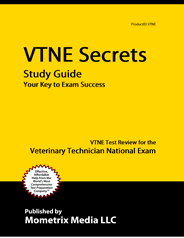VTNE Veterinary Technician National Exam Test Preparation Study Guide
The Veterinary Technician National Examination (VTNE) administered by the American Association of Veterinary State Boards (AAVSB). The purpose of VTNE is to evaluate whether an entry-level veterinary technician is competent to practice and get a credential . Professional Examination Service (PES) is responsible for the development and administration of VTNE and the exam is taken at Prometric Testing Centres throughout the US and Canada.
Format of The Veterinary Technician National Examination (VTNE):
The VTNE is administered in computer-based format. It consists of 200 multiple-choice scored questions and 25 pilot questions. The VTNE examination covers the following content areas:
7 Domains:
Pharmacy & Pharmacology
Surgical Prep. & Assisting
Dentistry
Laboratory Procedures
Animal Care and Nursing
Diagnostic Imaging
Anaesthesia and Analgesia
23 Task Areas From following areas:
Pharmacy and Pharmacology (14%)
Surgical Preparation and Assisting (16%)
Dentistry (8%)
Laboratory Procedures (15%)
Animal Care and Nursing (24%)
Diagnostic Imaging (8%)
Anaesthesia and Analgesia (15%)
47 Knowledge Areas:
01 Anatomy
02 Normal physiology including theriogenology (reproduction)
03 Pathophysiology (diseases and disease processes)
04 Common animal diseases
05 Medical terminology
06 Toxicology
07 Applied mathematics (including but not limited to metric system/weights, measures/percentage solutions, dosage calculations)
08 Drug classification
09 Routes of administration of pharmacological and biological agents
10 Legal requirements and procedures for preparing, storing, and dispensing pharmacological and biological agents
11 Contraindications, side effects, and normal and abnormal drug reactions and interactions
12 Fluid balance and therapy
13 Aseptic techniques
14 Sterilization techniques and quality assurance for equipment and supplies
15 Patient positioning techniques (including but not limited to diagnostic imaging, surgery)
16 Surgical procedures
17 Sterile and circulating (non-sterile) surgical assisting procedures and instrumentation
18 Suturing methods and techniques
19 Dentistry procedures (including but not limited to cleaning, floating, charting, preventive procedures, dental imaging)
20 Dental equipment, instruments, and supplies
21 Sample collection, preparation, storing, and shipping techniques
22 Laboratory diagnostic principles and procedures (e.g., haematology, cytology, urinalysis, serology, immunology, microbiology, parasitology)
23 Quality assurance in the laboratory (including but not limited to maintenance of equipment, verification of test results, calibration, controls)
24 Implications of abnormal laboratory and diagnostic test results
25 Animal assessment and monitoring techniques (including but not limited to surgery, hospitalization, physical exam, and excluding anaesthetic monitoring)
26 Principles of animal behavior
27 Clinical diagnostic procedures (including but not limited to blood pressure measurement, electrocardiography, tonometry)
28 Nutrition
29 Animal handling and restraint techniques
30 Animal husbandry
31 Animal nursing procedures (including but not limited to pre/post-operative care technique, casting, bandaging)
32 Animal first aid, triage, and emergency/critical care techniques
33 Public health (including but not limited to zoonosis, epidemiology)
34 Environmental health and safety procedures (including but not limited to handling and disposing hazardous material, personal safety, evacuation procedures, safety plans)
35 Disease control and prevention techniques (including but not limited to vaccination, wellness care, herd health)
36 Facility cleaning and disinfection techniques
37 Diagnostic imaging equipment and procedures (excluding dental imaging)
38 Quality assurance and safety for diagnostic imaging
39 Pre- and post-anaesthetic assessment and care
40 Anaesthetic induction, maintenance, monitoring, and recovery techniques including stages of anaesthesia, and troubleshooting
41 Pre-anaesthetic, anaesthetic, and analgesic medications
42 Pain assessment and analgesic administration techniques
43 Procedures for care, maintenance, and use of diagnostic, therapeutic, surgical, and anaesthetic equipment and supplies
44 Professional ethics (including but not limited to Veterinary Technician Code of Ethics)
45 Techniques for communicating with the veterinary medical team and client
46 Inventory control
47 Record keeping
Study Guide And Preparation Tips For The Veterinary Technician National Examination (VTNE):
A Complete Veterinary Technician National Examination study guide that includes sample questions, test tips and a complete study plan prepared by a team of expert and dedicated researchers. Cost-effective and qualified exam help from a committed exam preparation company.
Click here to order VTNE Secrets (printed book)
Click here to order VTNE Secrets (ebook access)
How to Prepare for Multiple Choice Questions
Tips and tricks that can help you prepare for multiple choice questions and increase your mark. Prepared by professionals these tricks help you excel in Veterinary Technician National Exam multiple choice exam.

